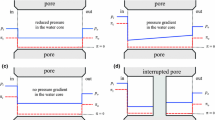Abstract
The response of yeast cells to osmotic pressure variations of the medium were studied through the kinetics of cell-volume modifications corresponding to the mass transfer of water and solutes. Osmotic variations were made by modification of the concentration of an external binary solution (polyol/water) without nutritive components. Two phases were distinguished in the thermodynamic response. A transient phase following an osmotic shift, which is characterised by rapid water transfer across the cell membrane and whose kinetics determine cell viability; then, a steady-state phase is reached when the cell volume becomes quasi-constant. The response of the cell during the transient phase depends on the level of the osmotic stress, and hence of the osmotic pressure of the medium. In the range of weak osmotic pressures, the metabolism of the cell is preserved through the maintenance of the intracellular turgor pressure. On the other hand in the range of high osmotic pressures of the medium, yeast cells behave as osmometers and no further metabolism occurs.
Similar content being viewed by others
References
ArnoldW. N. and LacyJ. S.: Permeability of the cell envelope and osmotic behavior inSaccharomyces cerevisiae, J. Bacteriol. 137 (1977), 564–571.
BernerJ.-L. and GervaisP.: A new visualization chamber to study the transient volumetric response of yeast cells submitted to osmotic shifts,Biotechnol. Bioeng. 43 (1994), 165–170.
BrownA. D.:Microbial Water Stress Physiology, Principles and Perspectives, Wiley, Chichester, England, 1990.
Dick, D. A. T.:Cell Water, Molecular Biology and Medicine Series, Bittar, Oxford University Press, 1966.
EdgleyM. and BrownA. D.: Response of xerotolerant and non-tolerant yeasts to water stress,J. Gen. Microbiol. 104 (1978), 343–345.
GelinasP., ToupinC. J. and GouletJ.: Cell water permeability and cryotolerance ofSaccharomyces cerevisiae, Lett. Appl. Microbiol.,12 (1991), 236–240.
GervaisP., MarechalP.-A., and MolinP.: Effects of the kinetics of osmotic pressure variation on yeast viability,Biotechnol. Bioeng. 40 (1992), 1435–1439.
GriffinD. M.: Water and microbial stress,Adv. Microb. Ecol. 5 (1981), 91–136.
KedemO. and KatchalskyA.: Thermodynamic analysis of the permeability of biological membranes to non-electrolytes,Biochim. Biophys. Acta,27 (1958), 229–246.
LevinR. L.: Water permeability of yeast cells at sub-zero temperatures,J. Membrane Biol. 46 (1979), 91–124.
Marechal, P. A.:Étude de la réponse cellulaire des levures soumises à des variations contrôlées du potentiel hydrique, Ph.D. Thesis, Université de Bourgogne, France, 1992.
MarechalP. A. and GervaisP.: Yeast viability related to the water potential variation: influence of the transient phase,Appl. Microbiol. Biotechnol. 42 (1994), 617–622.
MauroA.: Nature of solvent transfer in osmosis,Science,26 (1957), 252–253.
MeikleA. J., ReedR. H., and GaddG. M.: Osmotic adjustment and the accumulation of organic solutes in whole cells and protoplasts ofSaccharomyces cerevisiae, J. Gen. Microbiol. 134 (1988), 3049–3060.
MorrisG. J., WintersL., CoulsonG. E., and ClarkeK. J.: Effect of osmotic stress on the ultrastructure and viability of the yeastSaccharomyces cerevisiae, J. Gen. Microbiol. 129 (1983), 2023–2034.
MunnsR., GreenwayH., SetterT. L., and KuoJ.: Turgor pressure, volumetric elastic modulus, osmotic volume and ultrastructure ofChlorella emersonii grown at high and low external NaCl,J. Exp. Bot. 34 (1983), 144–145.
NiedermeyerW., ParishG. R., and MoorH.: Reactions of yeast cells to glycerol treatment,Protoplasma 92 (1977), 177–193.
NobelP. S.: The Boyle-Van't Hoff relation,J. Theor. Biol. 23 (1969), 375–379.
ReedR. H.: Transient breakdown in the selective permeability of the plasma membrane ofChlorella emersonii in response to hyperosmotic shock: Implication for cell water relations and osmotic adjustment,J. Membrane Biol. 82 (1984), 83–88.
SchwartzG. J. and DillerK. R.: Osmotic response of individual during freezing,Cryobiology 20 (1983), 61–77.
Steponkus, P.: Membrane destabilization resulting from freeze-induced dehydration, inCryo 87: 24th Annual Meeting, Society for Cryobiology, Edmonton, Canada, 1987.
ToupinC. J., MarcotteM., and LeMaguerM.: Osmotically-induced mass transfer in plant storage tissues: a mathematical model, Part 1,J. Food Eng. 10 (1989), 13–38.
ZimmermannU.: Physics of turgor and osmoregulation,Annu. Rev. Plant Phys. 29 (1978), 121–148.
Author information
Authors and Affiliations
Rights and permissions
About this article
Cite this article
Gervais, P., Molin, P., Marechal, P.A. et al. Thermodynamics of yeast cell osmoregulation: Passive mechanisms. J Biol Phys 22, 73–86 (1996). https://doi.org/10.1007/BF00954456
Received:
Accepted:
Issue Date:
DOI: https://doi.org/10.1007/BF00954456




